Visiting The Desbarats, Ontario Old Order Mennonite Community (42 Photos)

Have you ever visited an Old Order Mennonite community? One of our readers recently did, and shares a look at an off-the-beaten-path Ontario settlement in today’s post.
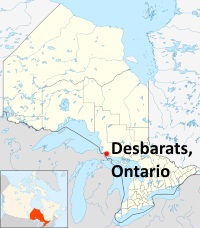 Old Order Mennonites are spiritual kin of the Amish. Similarities include language, plain dress, cultural values, and of course an Anabaptist religious heritage.
Old Order Mennonites are spiritual kin of the Amish. Similarities include language, plain dress, cultural values, and of course an Anabaptist religious heritage.
Amish and Old Order Mennonites live side-by-side in some places (like Lancaster County and the Nappanee, Indiana area), and sometimes cooperate in areas such as schooling.
There are also differences–including physical appearance, church discipline, and worship location (meetinghouses rather than home worship like the Amish), to name just a few.

Ontario is pretty well-known for its horse-and-buggy Mennonite population, perhaps even more so than for its Amish communities.
The Old Order Mennonite settlement near Desbarats (Township of Johnson) is located about a 45-minute drive from the US border, in an area adjacent to Michigan’s Upper Peninsula.
The community has been covered elsewhere in the media on at least one occasion. A site dedicated to the Sault Ste. Marie has an article on Mennonite participation in a local Farmer’s Market, which states that “start up would not have been possible without the support of the Mennonites.”
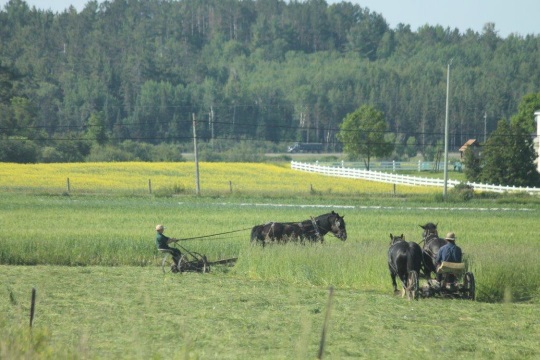
Unfortunately the article is undated and may be several years old, but we learn that the community was led by one Deacon and two Ministers at the time of writing. And there’s a somewhat confusing bit which may or may not suggest a total of 16 families. Here’s the origin story:
This area was chosen by the Mennonites because of skyrocketing land prices in Southern Ontario where urban sprawl presses in on prime farmland. In 2002, a land search committee recommended the area because of affordable agricultural land and room for growth. Although a location within a day’s buggy ride of a large centre would have been ideal, Johnson Township was acceptable because Bruce Mines and Desbarats could supply some of the necessities that cannot be produced on the farms, such as sugar, some feed supplies and baby chicks. The close access to Northern Quality Meats, the local abattoir, was also important.
Like the Amish, there is diversity among Old Order Mennonites. For example, most Old Order Mennonite men do not wear beards, but this community appears to be one of the exceptions.

The community at Desbarats appears to be one of the plainer ones. Says our contributor: “Very conservative community. They use snow and ice collected during the winter to “power” their coolers. They put up loose hay.”
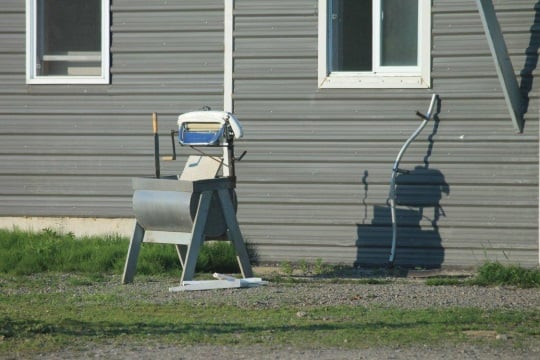
If you’re in the area, the market as well as area businesses sound like they’d be well worth a visit. There are quite a few of the latter, as you’ll see in today’s photos, and in this description from the above-mentioned article:
Today, income from farm produce can seldom supply all the needs of a family; and like almost all local farmers, the Mennonites do additional work, providing the following services: blacksmithing, harness making, saw milling, machining, woodworking, contracting in concrete, roofing and general maintenance, and operating agencies for wood cook stoves, steel siding and roofing.

More Info on Old Order Mennonites
My contact with Old Order Mennonites has been limited, and has usually happened when I’m in areas where both Amish and Mennonites live. On occasion we do write about Mennonite topics here (for example, see posts on Lancaster Mennonites moving to a new church house, a Mennonite-run Haiti auction, and an unusual mule-powered washing machine).
For more info on Old Order Mennonites, you can tap a variety of sources. There are good books of course. The one I’ve referenced in the past is called On The Backroad To Heaven: Old Order Hutterites, Mennonites, Amish and Brethren, by Donald Kraybill and Carl F. Bowman.
Though I’m sure other resources go more deeply into the Old Order Mennonite topic, that one is nice due to the side-by-side comparison of these related groups.
Also, here on the site, one of our readers, Osiah Horst, discussed Old Order Mennonite life in detail in a Q-and-A on one of his father Isaac Horst’s books.
Now, on to the Desbarats community. I’ve put our contributor’s comments below in italics, and the rest are mine.
The Desbarats, Ontario Old Order Mennonite Community

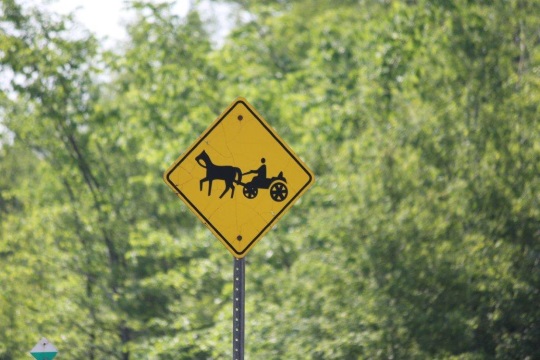
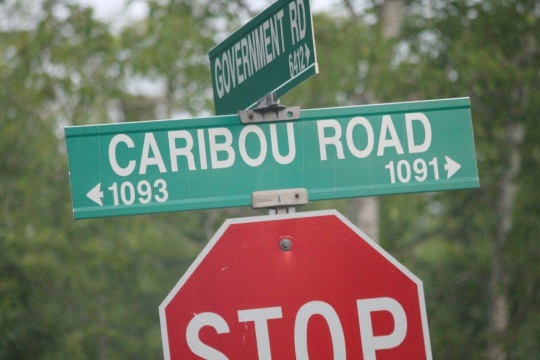
Both open and closed carriages are seen here.

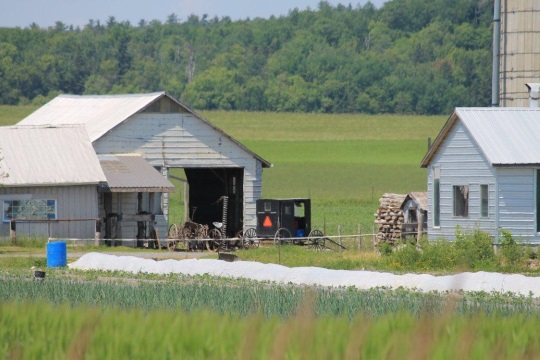
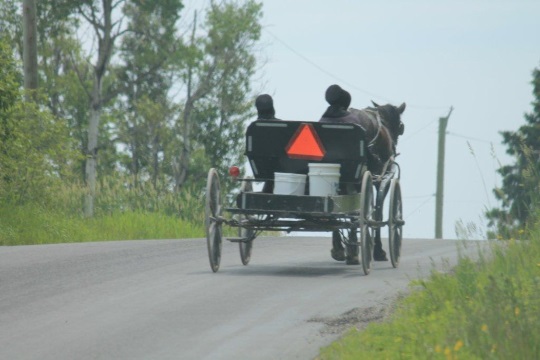
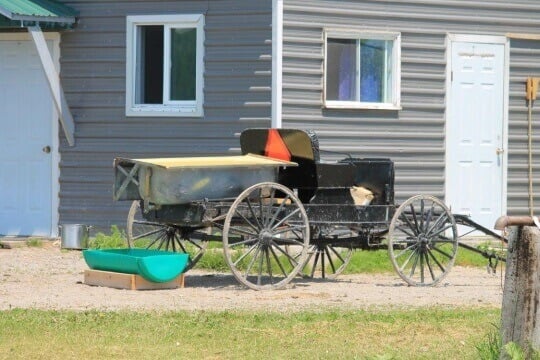
A wood shed attached to the house seemed to be a very common architectural feature. An English person told us they have multiple consecutive days of 30 below. No wonder they keep the wood close!


There are a variety of businesses in the area. Summer sausage sounds good. And, of course, maple syrup.
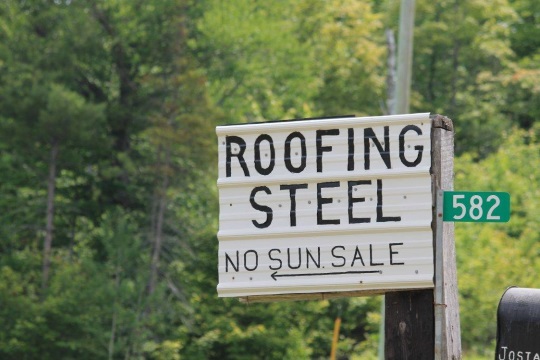
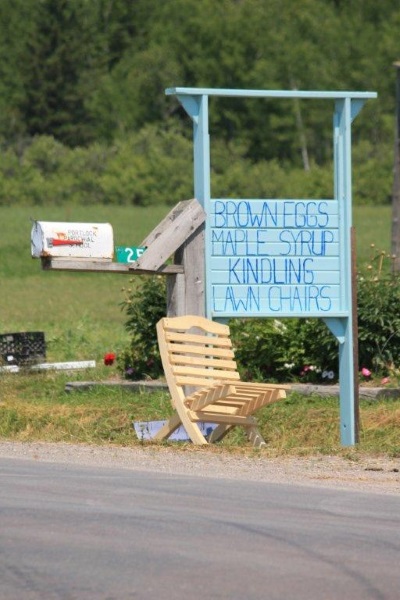

A very active community. People seem to do many things to make ends meet including produce, alpacas, sheep, cattle, bee keeping, maple syrup production, picking wild blue berries, wood working, baked goods…

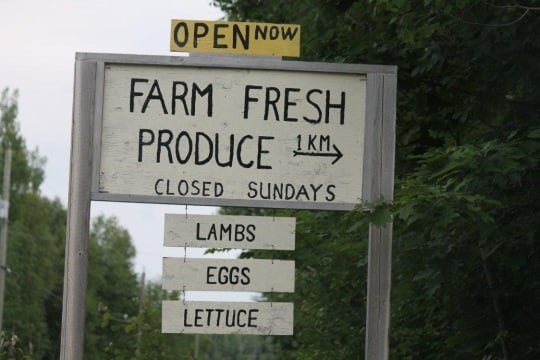
Directions to storage barn builder.
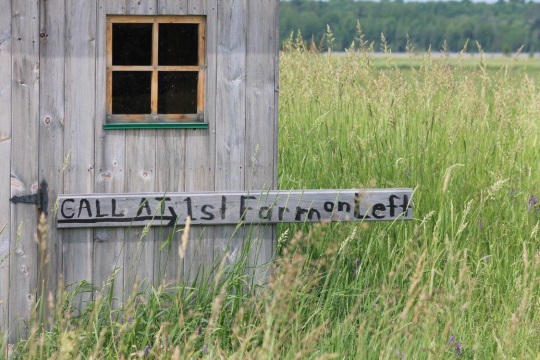


A couple things picked up from area businesses. The pie is apple, and the other food item is granola.

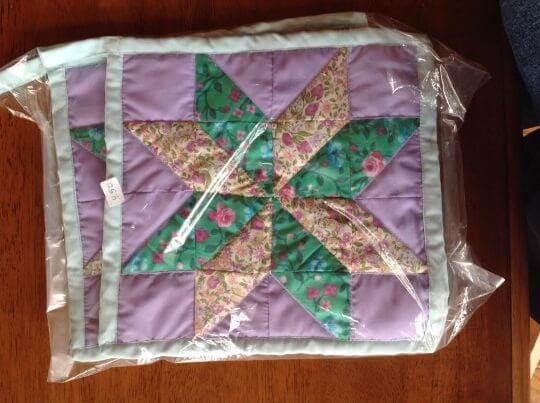
One of two portable sawmills we saw while driving through the community.
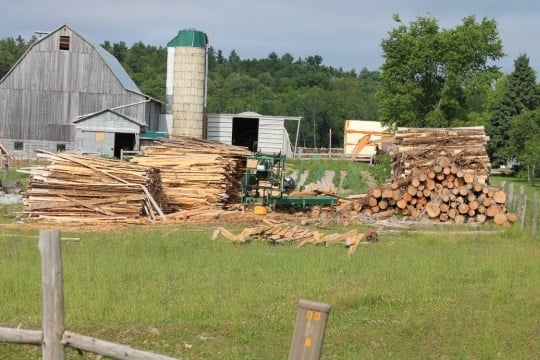
A maple syrup evaporator.
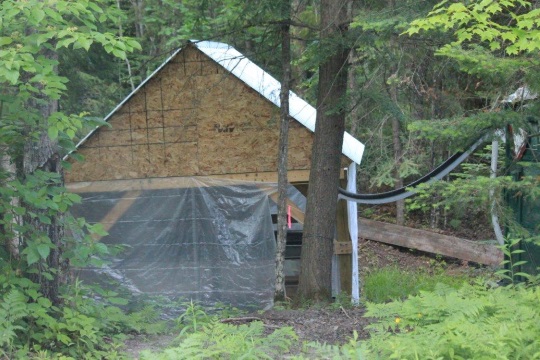
Agriculture is important here as well.



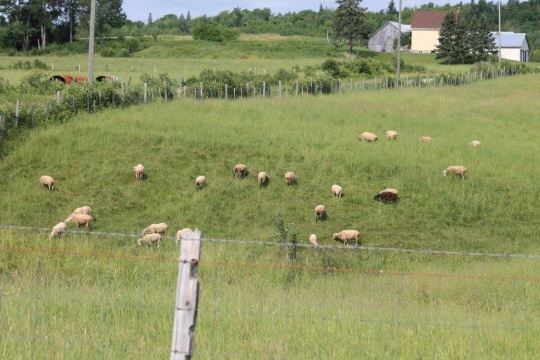
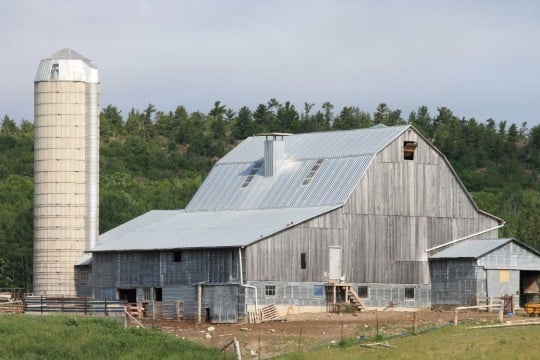
They grow kohl and cold crops throughout the growing season. They can plant, harvest and replant produce such as broccoli, cauliflower, spinach, kale, etc. Crops are shipped out by trucks to distant locations such as Manitoba.
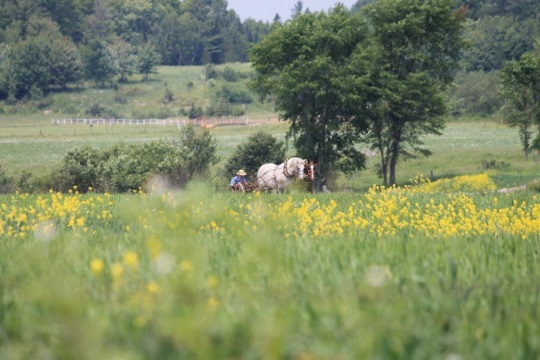
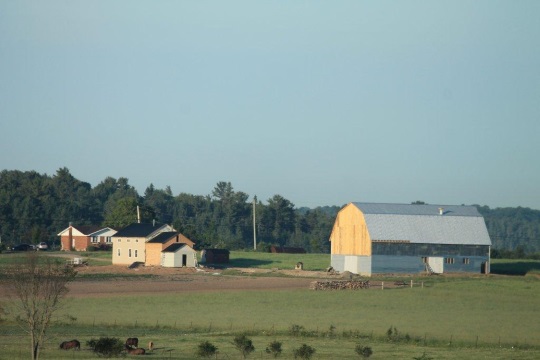

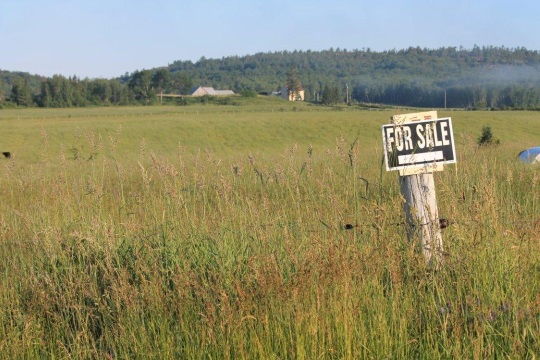
Looks like the container was too heavy and broke the wagon. Note the jack on the wagon bed.
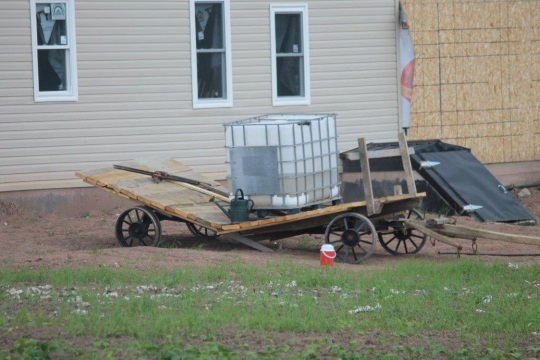
What are these boxes built on top of the roof? They have it on barns and homes. I have no idea what it is.


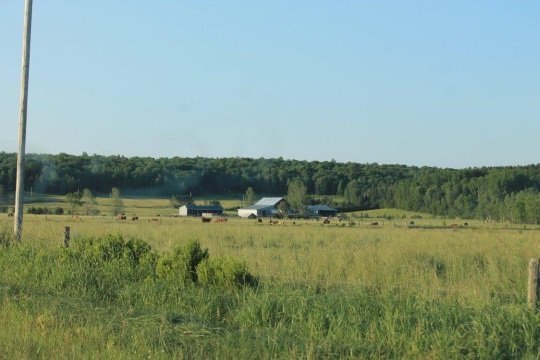
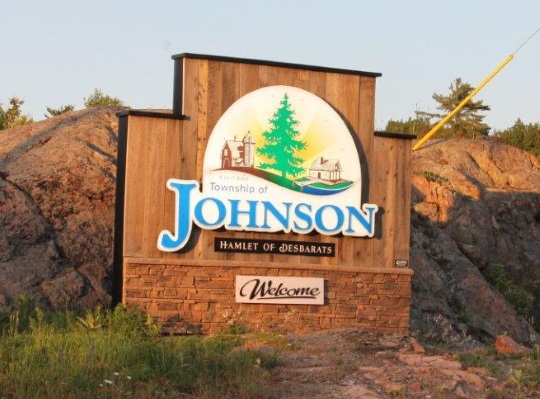
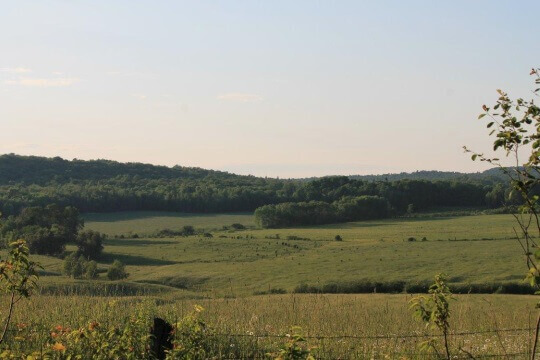
A special thanks to our contributor for this glimpse of a Canadian Mennonite community.
Have you visited an Old Order Mennonite area? What was your experience like?


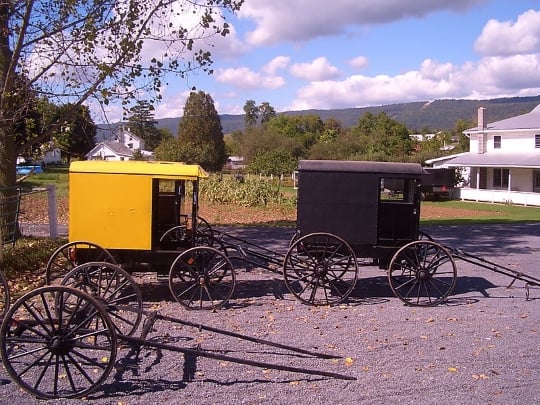

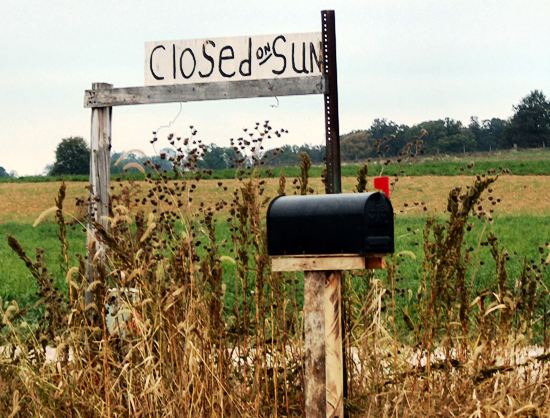
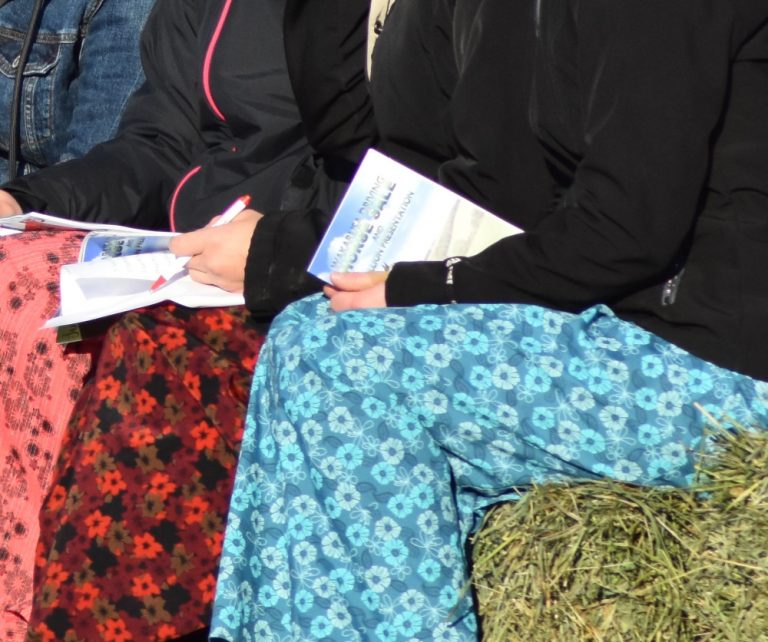
The boxes on the roof
Wouldn’t those boxes on their roofs be a “plain” version of a cupola? Today most cupolas that we see are of cosmetic nature versus the real purpose of them….to let the heat out. Without electricity and no fans, they create the “chimney effect” for air movement…up and out. Not a new invention by any means! For us wimps today we just turn the ac on!
Owl boxes?
That’s kind of what they looked like to me. But someone on the Facebook page had this to say:
Roger Martin The boxes on the roofs are “owl boxes”, encouraging owls to nest there. Owls do a great job on rats and mice.
https://www.facebook.com/permalink.php?story_fbid=903047036422410&id=122176297842825
Visiting The Desbarats, Ontario Old Order Mennonite Community
Looks like a fun place to visit
Orthodox Mennonites
Yes, the boxes on roof tops are ventilators. Normally when you see these on a barn or shed roof, you can tell you are in Old Order Mennonite country. They are very common even where electricity is used.
My sister Mrs. Silas (Esther Horst) Bowman and her family were one of the earliest families to move to this area. For them it was an opportunity to purchase land for themselves and their growing family. They live right on the Trans Canada Highway 17 about 30 minutes from Sault Saint Marie and sell produce at the end of the lane.
The community had 21 families in 2012 and would be over that by now with some couples marrying the last three years. They have a bishop, two ministers and a deacon. The first family moved to the area in February 2004.
The Orthodox Mennonites’ home community is in Southwestern Ontario near Gorrie so they are often called the Gorrie people. They had around 200 families in 2012 plus about 15 households in Snyder County Pa. and about 36 households in two Kentuckey settlements.
The Orthodox Mennonite Church had its origin in the Old Order Mennonite community of Waterloo County in early 1800 but formed as a separate group in 1957 to an attempt to return to older standards.
The men wear beards and the dress and living standards compare somewhat with Shwartzentruber Amish. Alcohol and tobacco are strictly forbidden and their moral standards are normally very high.
Maybe I missed this, but what is the difference between Orthodox Mennonites and Old Order Mennonites?
Wonderful! Thank you for sharing more information about this community!
Thank you for supplying more information on the history of this group.
Orthodox Mennonites
And most of all, we have a growing Orthodox community right here at Douglas in the Ottawa Valley. We got to know these families well during the time they were checking out farms first in Quebec just across the Ottawa River and now just twenty minutes from where we are. They did travel with us in our vans and stayed in our homes while looking at farms but now they only travel by horse or public transportation. In several cases children along with a parent, one from the Desbarats area, were flown by plane to Children’s Hospital of Eastern Ontario. This of course happens only in emergency situations.
The Douglas community are into regular mixed farming (no dairy) with quite a bit of emphasis on produce farming. There is a truss shop, a roofing steel supplier, a produce store and a saw mill in operation so far.
This was very interesting. I’d heard of the Gorrie people/ Orthodox Mennonites, but this was interesting to see the photos and learn a little more. I’ve seen the heading in “Die Botschaft,” but did not know who they were affiliated with.
Your Turn Now, Osiah!
Osiah Horst’s father, Isaac Horst, wrote *A Separate People: An Insider’s View of Old Order Mennonite Customs and Traditions* I think it’s time for Osiah to write a book on the Old Order Mennonites of Ontario, bringing us up-to-date on the topic.
I completely enjoyed reading this.
I didn’t realize that there where OO Mennonites on that part of the great lakes in Ontario, when I think of them geographically heading north, I think more around the Georgian Bay Lake Huron areas, but I suppose it does make sense that they’d move up that way, it certainly is a very rural area, popular I would think with diehard fishermen and people who want to retire and (well, fish)
When i think of the northern Michigan and ‘near north” Ontario and think of religion I think more of the 1600s Jesuits trying to gain Native converts and becoming martyrs to their faith instead (there is one at least one European who became a Saint because of his work in French colonial Ontario/Quebec/New France, and many a Catholic school is named for him in Ontario)
It is neat to think the Old Orders are inching more north and a way from big southern cities in the province (although S-S-M is a fair size)
1600s Jesuits in Ontario
St. Jean de Brébeuf is the Jesuit you’re referring to. There are other Jesuit and Companions who were martyrs from the same time period. The people who tortured and killed them were at war with the people who became Christian, that is, there were two separate indigenous “tribes.” St. Jean de Brébeuf wrote The Huron Carol, the Christmas carol. The English translation of the 1800s doesn’t match the original, so it’s best to look for the lyrics in the French and Huron languages. There’s a Canadian singer named Heather [something] who sings a couple verses in all 3 languages, using an accurate English translation. I hope I haven’t gone too far off the garden path with this comment.
Thank you for great pictures. Nice virtual vacation.
Old Order/Orthodox
In the Southern Ontario Waterloo County area, there is a group of old order Mennonites whose official name is Old Order Mennonites of Ontario. There are several other groups of old order Mennonites in Ontario, including the car driving group of which I am a part (Markham Waterloo Mennonites) and the Orthodox Mennonites.
The Orthodox Mennonites are what I would call ultra conservative – the men are bearded, they have no electricity, no phone, don’t ride in private cars except when there is no other way to travel. The Markham Waterloo Mennonites own black cars, use most modern technology for work purposes but not for entertainment. Markham Waterloo mennonites can identify with both Old Order and Orthodox Mennonites because our way of keeping church is very similar, our church calendar is very similar and our way of thinking is very similar.
Note that I capitalize Old Order when referring to the one group, but old order when I refer to the various old order type of plain groups.
And, Bill, I think Don Kraybill, Donald Martin, and Barb Draper have more time for writing on the subject of old order groups than I do!
I was in Waterloo a couple of years ago and stopped in at the Mennonite Story center in St. Jacobs. It was really a fascinating visit. The gentleman who was running the shop that day was a member of a less orthodox Mennonite church, and we had a good time talking about the different plain traditions in the US and Canada. He told me that something that might be of particular interest to me was that among some of the plainest Mennonite groups in that area–even the horse-and-buggy Mennonites, send their children to public schools. That floored me, and he said he always thought it was quite surprising as well.
So interesting! Such beautiful, bucolic, scenery, too. It was a virtual vacation for me, too, this being a day off for me. A visual treat!
Thank you for sharing!
Alice Mary
Mennonite information
Another good source on Mennonite groups is Stephen Scott’s “An Introduction to Old Order and Conservative Mennonite Groups.” There are several charts breaking down the different subgroups, with a description of each that I found very helpful. According to Stephen Scott’s research, the Gorrie Orthodox Mennonites are the result of a division the David Martin Old Order Mennonites, who pulled out of the Ontario Old Order Mennonites in 1917, desiring stricter church discipline. The Gorrie Group split off over concerns about the spiritual condition of the church and advocated higher moral standards, as Osiah Horst stated earlier. The Orthodox group itself divided in 1974 when some men began to wear beards. Others disapproved of this, and a separate group, also called Orthodox Mennonites, was formed.(See “An Introduction to Old Order and Conservative Mennonite Groups” pages 67-68) The writer Peter Hoover’s father was the leader of this second group and eventually led most of the members into the Conservative Mennonite Church. Peter Hoover had some information about this split on one of his websites.
Erik, “On the Backroad to Heaven” is a good resource, but I have been made aware that there are some discrepancies concerning the German Baptist Brethren. A member of the Brethren told me before I joined the church that there were a few details that made him wonder just how much research the author of that chapter did before writing it. The two example given were something about always facing the same way in a flowing stream when baptizing (no such custom exists) and watering down the wine at communion so members don’t get drunk. If the wine is watered down, it’s to stretch it so all can partake. Our communions are two-day affairs and often involve visitors from other districts, sometimes unannounced. I believe that we are the only Anabaptist group, other than the Amish who hold a literal foot-washing service as part of our communion. Perhaps someone could expand on that if possible. Other than those discrepancies (which are understandable, since the Brethren are the more unusual of the Anabaptist family), “On the Backroad to Heaven” seems to be a thorough book and a good resource for curious minds.
I appreciated and enjoyed this post. It’s a rare treat to see photos from Canada!
Oops!
Erik, I would like to apologize to you and the other readers. I was misinformed about “On the Backroad to Heaven.” There IS a custom among the Brethren as to which way we face when baptizing. I don’t remember now if it’s upstream or downstream, but there is a historical tradition of facing a certain way. It’s just hasn’t been emphasized to the younger generation, I guess. As to the wine and mixing it with water, that may be because the Bible speaks of “mingling” the wine, so that might be what was seen. The chapter on the Brethren had input from the Brethren, so it should be accurate. It’s certainly not like Dr. Kraybill to make a mistake like the ones I suggested, and for that I apologize and retract anything I said negative about the book. That which was positive still stands and is reinforced. Thank you.
Footwashing
Hello, Nicholas!
Foot washing is practiced much more widely than you suggest, not only by Anabaptists but also by traditionalist Baptists.
Footwashing
Bill Rushby,
I did not mean to suggest that it isn’t widely practiced, but rather an actual footwashing service in the old orders is rather limited to Amish and German Baptist Brethren. Sorry for the confusion!
I am pleased to hear the traditional Baptists still practice it, and I know that at least some Church of God (Anderson, IN) congregations still practice it some. I find it to be a very deep spiritual experience with a great amount of intimacy for the congregation. I wonder if the Orthodox Mennonites practice it? I think the adoption of beards may have been from Amish influence, but I could be thinking of the Noah Hoover Mennonites.
Thanks!
I just wanted to say thank you for these wonderful posts. They are so educational. I also am so appreciative of everyone’s comments. This website is a treasure indee.
Our pleasure Leilah! Thanks for reading and commenting 🙂
Footwashing
Feetwashing is practised twice a year or at every communion service among all old order groups Mennonite groups. The
Orthodox began wearing the beard after being challenged by the Kentucky group. Perhaps that is the Noah Hoover group.
Would the Noah Hoover group live close to Liberty, KY in Casey County, near the Galilean Home ? There was a group there 2 years ago when I lived down there for a few months that lived much like you describe the Orthodox Mennonites. They mostly moved to Tennessee in late 2013 and 2014. There were also Joe Wenger Mennonites there. And a group called Casey County Amish, that dressed very plain, but each family was allowed 1 car. They affiliated with a NC Amish church that also had a church house, but no cars.
Rebecca, my information states that the Noah Hoover group is located a few counties southwest, near Scottsville, in Allen County. Of course, this information is also about 20 years old. Maybe Osiah Horst knows more. I might know someone who knows more about this group from when his family lived in Pennsylvania. I think it’s the Noah Hoover’s that they knew there before the whole group went to Kentucky. Interesting about the Casey Co. Amish, that they allow 1 car per family. Is the NC Amish group still there? Or is it one that disbanded?
I believe it was the Union Grove, NC congregation they affiliated with. I don’t think the NC group had cars, though. And the OO Mennonites in Casey County were , I believe, a break-away group from the Joe Wengers, and as I mentioned moved on to Tennessee. I think Swartzentruber Amish moved into the area and bought farms from them.
Casey County Midwest Beachy
The Casey Amish Church in Casey County, Liberty, Kentucky, is listed as Midwest Beachy in Cory Anderson’s book.
http://gameo.org/index.php?title=Midwest_Beachy_Amish_Mennonite_Church
Thanks, Linda, I never got to know any of them , but saw them around and working in the stores. They actually dress plainer than many OO Amish I know.
Footwashing
Osiah, thank you for setting me straight. For some reason, I thought that a literal feetwashing service was one of the differences between the Amish and OO Mennonites. I don’t know where I heard or read this. Glad to correct that error!
I just looked back at Steven Scott’s book on OO Mennonite groups and I think you are right that the Noah Hoover group is the one that challenged the Orthodox. Scott writes that they have some relationship with the Gorrie people and in another part of the book, he writes that the Orthodox began wearing beards after associating with them. The Noah Hoover group is a branch of the Stauffer Mennonite subgroup, according to Scott.
Literal Footwahing Service?
Hello, Nicholas!
I don’t understand what you mean by “a literal footwashing service.” Please explain.
Many groups practice footwashing as part of the communion ritual. This includes German Baptists.
Feetwashing
Greetings, Bill!
A literal footwashing service is how I have heard the practice of washing the feet of your fellow congregants called in some scholarly writing concerning the Amish (I think). By this I mean that we actually wash each others’ feet (just prior to the Lord’s Supper, which is an actual meal followed by the Bread and Wine of Communion). The Church of God (Anderson, IN) where I grew up did not include this as a part of the communion ritual. Nor have any other groups with which I have visited, worshiped or taken communion (prior to my joining the German Baptist Brethren). This would include some mega churches, the Roman Catholic Church, Episcopalian, Church of Christ, Non-Denominational, some kind of Baptist (during a mission trip) and a liberal Mennonite church (come to think of it, I don’t think they ever had communion when I was attending there). Most or all of these only had the Bread and Wine (or grape juice). If footwashing was observed it was done separately. I now remember the Moravians also practiced footwashing. Can’t seem to remember if the Quakers do.
To clarify some possible confusion,the Old German Baptist Brethren are not Baptists in the same sense as groups like the Southern Baptists. The term “baptist” refers to their practice of baptizing adults on confession of faith (by immersion). Their origins are in Schwarzenau, Germany in 1708 with Alexander Mack organizing a group of like minded believers. They were influenced by both the Anabaptist movement and the Lutheran Pietist movement. The German Baptists are considered a part of the larger Anabaptist movement today, and we hold many beliefs and practices in common with other old order Anabaptist like the Old Order Amish, Beachy Amish, and the various types of OO Mennonites, but more with the car groups. I was told that when the GBs immigrated to Pennsylvania from Germany to escape persecution, they considered merging with the Mennonites there. Because the Mennonites in PA at that time baptized by pouring, this did not happen.
I am very glad to learn that more groups than I thought practice actual (literal) feetwashing, as I find it a most wonderful experience that brings us closer as a church.
Nicholas,
My father’s family were all Quakers and on my mother’s side my grandparents were German Baptist Brethren (grandfather) and Brethren (grandmother). I know some about the Quakers and the Brethren but very little about the GBB. The only thing I have learned is what Wikipedia says. What can you tell me?
Thanks, in advance.
To answer your question about Quakers and foot washing, no, they do not practice that nor do they take communion. I forgot to answer that in my last writing.
Quakers (Friends) and Ordinances
Harriet stated that Friends do not practice footwashing, nor do they take communion.
Actually, some Friends do practice the ordinances. In the Eastern Region of Evangelical Friends, as far as I know, use of the ordinances is a decision made by the local congregation. There are other scattered congregations where communion, in the conventional sense, is also practiced. I happen to be a Conservative Friend, so I don’t know my way around the world of “pastoral Friends” very well–but I think some meetings in Indiana have a permissive attitude toward use of the ordinances.
Some Conservative Friends, especially in Ohio Yearly Meeting, have undergone water baptism.
There is a story about two Friends in the Marlborough Meeting in southeastern Pennsylvania finally settling a long-standing feud with each other. They celebrated their reconciliation by washing each other’s feet.
It is not quite accurate to assert that the Friends do not practice baptism and/or communion. The “party line” theology is that they spiritualize baptism and communion.
Sorry Bill,
I should not have made a blanket statement. In the Quaker churches that my family has attended, communion and foot washing are not practiced. If we have learned anything on this website, it is that the practices of all Amish, all Mennonite, etc are not necessarily the same.
I was fairly sure that my family did not take communion/practice foot washing so I confirmed that with my aunt. They live in the area of Kokomo, IN.
Sorry for any confusion.
German Baptist Brethren
Harriet,
The Old German Baptist Brethren, like others in the wider Brethren denominations originated as I stated earlier, in Schwarzenau, Germany in 1708 and most or all of the group had emigrated to North America by the mid-1730s to escape persecution. In 1881, a massive split occurred in the church, creating the old order group, called the Old German Baptist Brethren Church (OGBBC). The progressive side of the divide is the Church of the Brethren. The OGBBC retains the two-kingdom doctrine and it’s associated practices, such as non-resistance, non-swearing of oaths, not suing at the law, etc. A wider separation from the “world” or larger society is practiced than in most Christian groups, but not to the extent as seen in the more traditional Amish groups. This separation, in addition to the practices previously mentioned, takes the form of avoiding popular entertainment media such as TV, movies, radios in cars, the famous plain clothing (we are mistaken for Amish quite a bit, and also, less commonly, for Mennonites), not getting entangled with the government (no voting) and other similar practices in our daily lives. The women’s head covering is practiced.
Unlike the Amish, there is a centralized church government in the form of an Annual Meeting, where the entire denomination gathers and sends representatives of each district (or congregation) to discuss issues in the church. A decision will be made at the meeting that will affect the entire group. The brothers vote on an answer given by leadership to determine if the larger church will accept it or not. If not, a satisfactory answer will be found through suggestions from those present, not just the leadership.
In 2009, the OGBBC suffered another major split, with approximately one third of the membership withdrawing. Most of those who withdrew reorganized into the Old German Baptist Brethren Church-New Conference. The New Conference (NC) is distinguished from the OGBBC in several ways, most pertaining to issues of the split. The two larger issues were the use of internet and role of the church. Smaller issues included organized Bible Studies and church discipline (Matt. 18) or more correctly, the improper use of church discipline (it was felt by some that the first two steps were being skipped more often than not and issues were taken straight to the local church district). The Annual Meeting answer to internet in the home was members should not have it, and you had three years to get off (2015 saw the approval of internet for legitimate business practices). The role of the church was feared to be getting too close to that of Christ in certain areas, and this helped divide the membership. One of the questions sent to the Meeting was handled in such a way that many did not want to accept the answer (voting is done by “voice,” that is, calling out your vote verbally when asked. This particular instance involved what many thought to be a voice that was too close to call, but it was called anyway, because the foreman thought he heard a majority. I was not present, so I can’t tell you more.).
The differences in practice between the NC (of which I am a member) and the mainstream OGBBC vary from community to community and individually. The main ones are: NC permits internet in the home (though not all have it); greater personal choice in some forms of entertainment (a number have radios in cars, but TV and going to movies is still off limits); organized, church sanctioned Bible studies; more open involvement in mission and service work; participation when necessary (such as when few ministers or deacons present) of the laity in leading worship. In our appearance, there isn’t much difference, although sisters tend to wear sweaters with their cape dresses more often, the impractical shawl is seen very seldom, men don’t wear the broad-brimmed hat but seldom, broadfall trousers are not as common as they once were (they are required in the OGBBC, either with belt or suspenders. Suspenders are rare in the NC. A few wear them with their suits, and occasionally with work clothes. Only one brother wears them during the week fairly regularly in my district, yours truly.). We have other differences in technology, worship, and practical applications, but some are rather minor, and it wouldn’t do to try to list them all right now.
I hope this helps, Harriet.
Peace.
I hope
Thanks, Nicholas for your reply. I have always wondered about the part of my family that called themselves “Dunkards”. I have seen their church(Carroll County, IN) but none were around during my lifetime.
What did you mean when you said, “The role of the church was feared to be getting too close to that of Christ in certain areas?”
Thanks again!!
Harriet, I think the worry was that the authority of the church would become equal to that of Christ and that decisions of the church at the Annual Meeting would be seen to be just as binding as those commands of Jesus. I am not entirely sure, as I was not there and only have this as second hand information. Anyhow, the church is not in that position, officially or unofficially. For some individuals, though, it might be.
What do you mean that none were around during your lifetime? There is a sizable community of OGBBs and NC there in Carroll Co., IN. I actually work with someone from there. We both live in the Anderson/Pendleton (Madison County)area in Indiana now, though.
Your explanation makes perfect sense. Thanks. Isn’t that a common problem in many churches????
What I meant about none being around, is my family that worshiped there were all dead before I was born. My grandfather left home at age 14, and raised himself from that time on. He married my grandmother who was a Brethren. They didn’t go to church too much, mostly holidays, until I was born and then we attended a Baptist church.
I really appreciate your information. It makes that part of my family a little more “alive”. (Sick choice of words!! Ha!!)
So many names!!
Sometimes when I read Amish America I am amazed to discover a new group, today reading the commends I came across the Mennonite subgroup the The Noah Hoover people. I haven’t been as keen into Mennonites, but I’d not heard of them.. I’ll have to check out GAMEO and read about them if they got something up there…. ha, something to explore over the weekend!
Ontario Mennonites
These folks look similar to the Pikers here in Pennsylvania only Piker men don’t wear beards. Erik, did you get my email and photos of the Big Spring Farm Threshing demonstration?
Terry
I did, thank you Terry! Sorry haven’t written back yet. Will do soon.
many groups
what a lovely post. I just got back for the Amish/Mennonite community in St. Jacobs Ontario yesterday, and had a wonderful visit I had. I also visited the Amish in Norwich Ontario, just outside of Woodstock, Ontario. I found that area to be very beautiful, with lovely farm lands. To me the area isn’t overrun by us tourists, and it was just nice to view the farms and the area. Stop by the roadside stands, and get to know the people. I know there are settlements in Aylmer, Kincardine, and not too far from me in Leamington, Ontario, but I didn’t realize they were up that high near the Sault. Its nice to learn of new areas, and what they have to offer and what believes they may share. Thanks, Marie from Windsor, Ontario Canada
No worries Erik. If you like I could you more information on the event. Also have a pretty interesting video clip too.
Terry
Orthodox Mennonites
The Orthodox Mennonites are located in Snyder County, Pa. (and have a Stauffer background), in Trigg County, KY (these appear to be from the Groffdale or {Joe Wengers}conference in Pa.) and in Christian and Todd Counties Ky. (2/3 of the family names in this community are Hoover so chances are they are the Noah Hoovers.
Osiah, would you know how many fellowships of Stauffer Mennonites there are? I did look it up in a book, but I’m wondering if the book might be out of date. We met a really nice Stauffer couple recently and from what they said I’m guessing there are at least three groups. I later wished I had asked them.
Stauffer Mennonites
I have very limited knowledge of the Stauffer churches. I understand that there are a number of quite small groups who are Stauffer related. I believe there is a Stauffer settlement not too far from Rochester NY who probably associate with the larger Pa. group. I suppose GAMEO would give us some information although it gets to be dated as well.
I know some of these folks
I was at the farm of Silas and Esther Bowman this morning to buy some of their produce and saw them studying a sheaf of paper and chatting about what they were seeing and reading . I have been buying eggs and produce from them since shortly after they moved to the Desbarats area and have gotten to know them. Imagine my surprise when they showed me a printed copy of this posting. They were enjoying trying to figure out whose house or barn or outbuilding was in the picture. Some they knew, some they didn’t. I came home and did a search for the article. I enjoyed looking at it and have learned a lot from reading the comments. Silas commented that they appreciated that whoever took the pictures respected their wish not to be photographed. The community at Desbarats has grown well beyond the original 12 or so families. They are good people and I think that the area is richer for their being here.
Orthodox Mennonites
It sure is interesting how this gets around, Pat. Imagine talking about some small, almost obscure group in Northern Ontario and then finding a neighbour who actually knows the people. It reminds me how important it is to always be respectful of others and to try to give as accurate a description as possible without relying on heresay.
Orthodox Mennonite, Scottsville Hoover Mennonite
Johnson Township is located in Ontario’s Algoma District.
http://gameo.org/index.php?title=Orthodox_Mennonite_Church
(GAMEO, Orthodox Mennonite Church. Canada, Belize, Scottsville, KY)
“After the first united communion meeting, held on 6 April 1958, the merged groups (the Hoovers, the Nolt Group, the Plattdeutsch families from Mexico, and the Samuel Horst group) chose to call themselves the Orthodox Mennonite Church.
The Orthodox Mennonites do not have a written standard and have been unusually flexible in making lifestyle changes—all of them tending to greater simplicity and nonconformity to the world.
Contact with the merged Titus Hoover and Amish Christian Church in Pennsylvania, Tennessee and Kentucky continued on a sporadic basis, as well as contact with the group led by Jonas Nolt and Ben Lavy at Mammoth Springs, Arkansas, and the one led by John W. Martin and Albert Stoll at St. Joe, Arkansas (see Pure Church Movement).
In 1999 a group of Old Order Mennonites at Kinloss, Ontario, merged with the Orthodox, followed by another group of the same background in Trigg County, Kentucky. In 2001 the Phares S. Stauffer Group of Snyder County, Pennsylvania united with the Orthodox as did the Henry Hoover Group (a branch of the Reidenbach Mennonites) living in Trigg and Christian Counties, Kentucky in 2005.
During the 1990s members of the Canadian Orthodox Mennonite communities began to move into the Algoma Region of northern Ontario, and in 2006 a group leaving their fellowship moved to Gladstone, Manitoba, Canada. All told, the Orthodox Mennonites met for worship in nine locations, not all of them with meetinghouses, in 2010. A respectful relationship continued with the Scottsville Mennonite Community in Kentucky, along with its branches in Missouri, Tennessee and Belize, (the main surviving body of the merged Titus Hoover and Amish Christian Church), as with the Barton Creek Mennonite Communities in Belize, Central America.”
Donald Martin wrote a book, Old Order Mennonites of Ontario: Gelassenheit, Discipleship, Brotherhood. Kitchener, Ont: Pandora Press, 2003.
-https://en.wikipedia.org/wiki/Noah_Hoover_Mennonite
(Noah Hoover Mennonite, Scottsville, KY)
“Noah Hoover Mennonite, called “Old Order Mennonite Church (Hoover)” by the Mennonite World Conference, and sometimes called “Scottsville Mennonite”, is a group of of Old Order Mennonites that originally came from the Stauffer Mennonites and later merged with several other groups.
In 1987 Noah Hoover Mennonites were located in Snyder County, Pennsylvania, Allen County, Kentucky (near Scottsville) and Upper Barton Creek in Belize, Central America. They had an associated group in Huron County, Ontario. In 1988, they left Snyder County and shifted their center to Scottsville, Kentucky, where they created their main settlement.
Concerning the use of technology the group is the most conservative of all Mennonite groups as they permit no engine power at all. Their Plain dress looks very similar to the dress of Old Order Amish and since men wear beards, they can easily be taken for Old Order Amish. They use mostly Standard German for Church and Bible reading, and Pennsylvania German and Plautdietsch (in Belize) in everyday life.
In 2015 the group had the following communities (or church districts or settlements): three in Allen County, Kentucky (two west of Scottsville and one near Holland), two in Missouri (Rich Hill and Richards), one in Ohio, north of Winchester, one in Delano, Tennessee and three in Belize.
The Book, Better Off: Flipping the Switch on Technology by Eric Brende describes the Noah Hoover Mennonite Community near Scottsville without mentioning the name of the group.”
https://www.google.com/maps/d/u/0/viewer?mid=zSiyW-9TZtYU.k3IsVGUT2cPE&hl=en_US
(Allen County Mennonites, Scottsville, KY), 21 businesses on Google Maps. Mennonite communities in Allen County offering Farm and Home products.
http://www.thecanadianencyclopedia.ca/en/article/mennonites/
(Mennonites in Canada)
“Old Order Mennonites accept neither health care nor education paid by the state.”
Additional Research
Thank you for writing this article! The community in Desbarats has done incredibly well in terms of growth of the population and agricultural expansion. I am currently working on a research project that examines the movement of Old Order Mennonites to northern Ontario and have worked closely with this community. If there is any interest, a report myself and another student wrote is available on our project website http://www.enhancinglocalfood.com and an additional report from a second northern community of Old Order Mennonites will be available later this summer (pending final approval from the community).